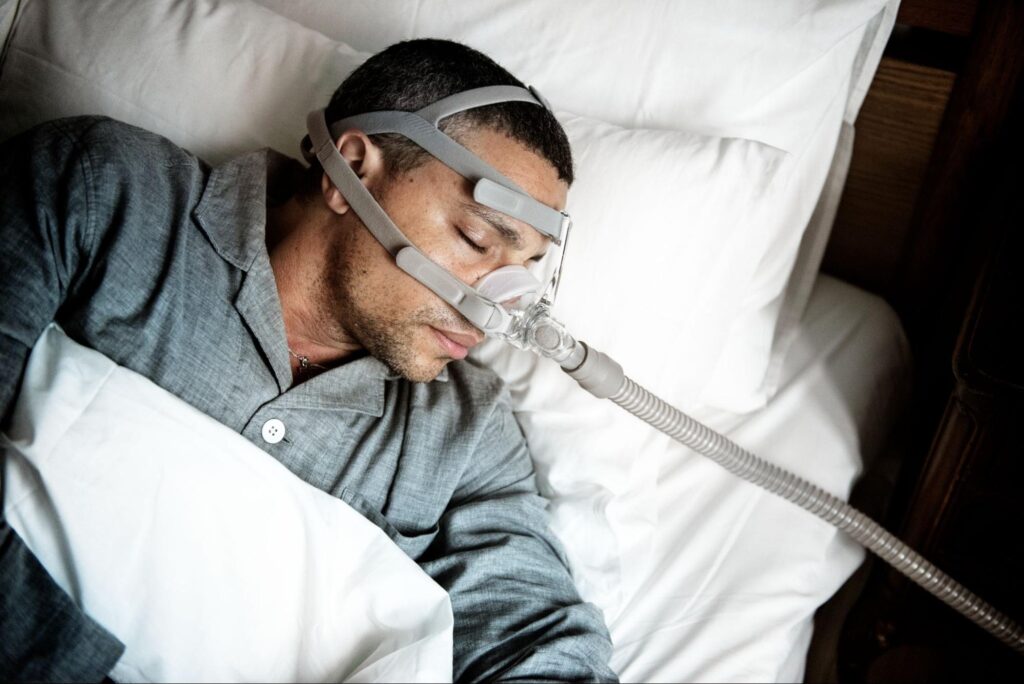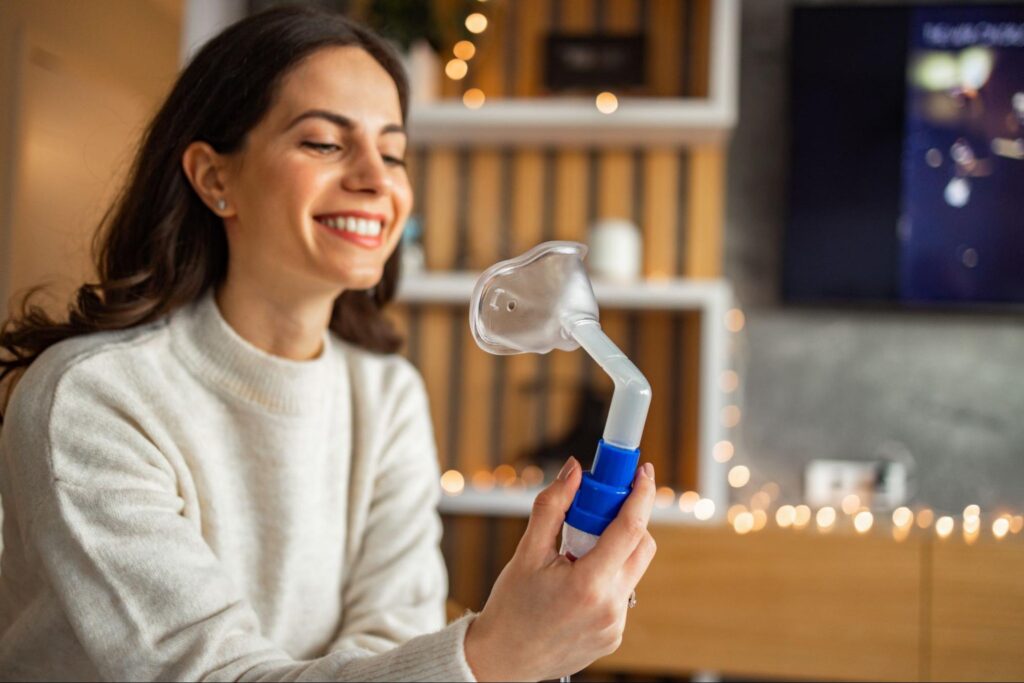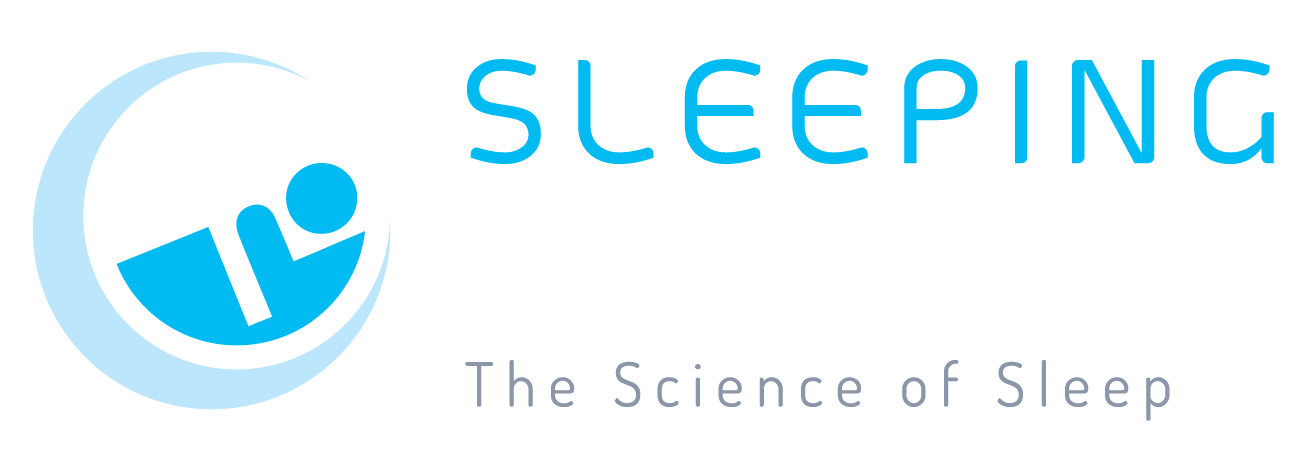
Receiving a CPAP machine marks a significant step towards improving sleep apnea, but getting used to it can feel daunting. This guide will prepare you for your first few nights, addressing common feelings and practical steps. We’ll cover what a CPAP machine is, how to set it up to work with your mask, managing comfort, and navigating the adjustment period.
Understanding Your CPAP Machine: The Basics of How it Works
A CPAP machine’s main function is to help treat sleep apnea. How it works is by delivering a continuous stream of pressurised air to keep your airways open while you sleep. The continuous airflow stops your tongue, soft palate, and uvula from shifting into your airway. A CPAP machine has three main parts:
- The machine itself, with a motor that filters and pressurises the air
- Tubing that carries the airflow
- A mask that fits over your nose and mouth
Although the device may look complex, its purpose is simple: it helps you breathe and sleep better. It takes in air from the room, filters it, and delivers it to you.
Your CPAP Machine Setup: Getting Started
Once you’ve received your CPAP set from your local sleep clinic in Malaysia, the first step is to set it up at home. The good news is that the process is straightforward. Here are the simple steps to follow for the initial setup.
- Connect the Tubing: Securely attach one end of the tubing to the air outlet on the CPAP machine. Then, connect the other end of the tube to your mask. You should hear or feel a click to confirm a tight seal.
- Fill the Humidifier: If your machine has a humidifier, fill its water chamber with distilled water up to the indicated “MAX” fill line. This prevents mineral build-up and ensures you’re breathing clean, moist air.
- Plug it In: Connect the power cord to the back of the machine, then plug it into an electrical outlet. Make sure the cord is placed where it won’t be a tripping hazard.
- Insert the Filter: Double-check that the air filter is properly inserted into its designated compartment on the machine. This purifies the air drawn from the room before it reaches you.
Using a CPAP machine for the first time may not be intuitive, but the process is manageable. We advise following the manufacturer’s instructions for your specific model to ensure a safe and effective setup.
Mastering Your Mask: Tips for Comfort and Fit
How to Use a CPAP Mask Effectively
The mask you use with your CPAP machine is crucial for both comfort and a proper seal. It needs to be snug but not so tight that it pinches your face or causes discomfort. Achieving the right fit ensures the pressurised air goes where it needs to. There are different types of masks, and selecting the right one depends on your needs.
- Nasal Mask: This type covers only your nose. It is often recommended if you breathe through your nose and tend to move around a lot during sleep, as it provides a stable fit.
- Nasal Pillow Mask: Rather than covering the entire nose, this mask uses soft prongs or cushions to seal at the base of your nostrils. This is a good option if you feel claustrophobic or wear glasses and enjoy reading with your mask on, as it provides a clear field of vision. However, it may not be suitable if you have nasal congestion or tend to breathe through your mouth.
- Full Mask: This triangular mask fits over your nose and mouth. A full-face mask is a good choice if you are a mouth breather or have a nasal blockage due to allergies or a cold.
- Hybrid Mask: This is a type of full-face mask that fits over your mouth but seals the nostrils with cushions or prongs. It is a streamlined alternative to a traditional full-face mask.
When you’re first getting started, you may need to try several mask types to find the best fit. Your initial mask might not feel right, so it’s a good idea to work with a sleep specialist to find the most comfortable option. It’s also a good idea to perform a “leak check” before lying down to ensure a proper seal.
Addressing Initial Mask Discomfort
It’s completely normal to feel claustrophobic or uncomfortable when first putting on the mask. A simple way to get used to the sensation is to wear the mask for short periods while you’re awake, such as when you are watching television or reading a book.
If your CPAP machine has a “ramp” feature, it’s a good idea to use it. This feature starts with lower pressure and gradually increases the pressure as you fall asleep, helping you ease into the therapy.
How Long Does It Take to Get Used to Using a CPAP?
The time it takes to get used to using a CPAP machine varies, but most people find comfort and consistency within a few weeks. The key is to be patient with yourself. Using the machine every night, even just for short periods at first, helps your body adapt faster.
Remember that some minor discomforts are normal initially and can often be resolved with simple adjustments to your equipment. Supplementing it with lifestyle changes will no doubt help your process.
Common Challenges and Solutions in Your First Nights
Adjusting to your CPAP machine often involves navigating a few initial challenges. The good news is that these are common and there are straightforward solutions to help you get the most out of your therapy right from the start.
- Dryness or Congestion
- What happens: The flow of dry, pressurised air can cause dryness in your nose, throat, or mouth, leading to discomfort or a stuffy feeling.
- What you can do: Your humidifier is a powerful tool here. Use it to add moisture to the air and adjust the humidity settings for your comfort. Saline nasal sprays or decongestants can also provide relief if you’re feeling particularly congested.
- Air Leaks
- What happens: An air leak occurs when the mask doesn’t form a proper seal, allowing air to escape. This can reduce the effectiveness of the therapy and cause irritating air to blow into your eyes or face.
- What you can do: Recheck the mask fit and straps to ensure a proper seal. Avoid overtightening, as this can worsen leaks and cause uncomfortable pressure marks. If the problem persists, your mask cushion or other components may be worn out and need to be replaced.
- Understanding Pressure Settings and Potential Issues
- What happens: Your pressure settings are precisely prescribed by your sleep specialist in Malaysia based on your specific needs. Sometimes, the pressure may feel too high or too low, leading to discomfort. One common issue is aerophagia, which is the swallowing of air, and it can cause bloating or gas. This is a potential side effect of CPAP pressure being too high.
- What you can do: If you feel the pressure is not right or you’re experiencing side effects, you should consult with your sleep specialist in Malaysia. They can make a precise adjustment to your pressure settings to ensure your therapy is both effective and comfortable.
Your Journey to Better Sleep Starts Now

Adjusting to a CPAP machine is a process, but the long-term benefits for your health and energy are significant. Remember to be patient and persistent; every night of use brings you closer to restorative sleep and a healthier life. The initial challenges you face are manageable, and you don’t have to navigate them alone.
If you face persistent challenges or have questions about your CPAP machine, our team is ready to assist. Reach out to a sleep clinic in Malaysia like Sleeping Lab for support.

